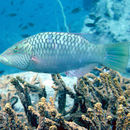Diagnostic Description
provided by Fishbase
Differs from the very similar C. unifasciatus by always lacking the white bar in front of the caudal base as well as the area clear of red streaks extending from the eye to just above the pectoral axis (Ref. 1602).
Diseases and Parasites
provided by Fishbase
Transversotrema Infestation 2. Parasitic infestations (protozoa, worms, etc.)
Life Cycle
provided by Fishbase
Oviparous, distinct pairing during breeding (Ref. 205).
Morphology
provided by Fishbase
Dorsal spines (total): 9; Dorsal soft rays (total): 10; Analspines: 3; Analsoft rays: 8 - 11
Trophic Strategy
provided by Fishbase
Occurs inshore (Ref. 75154).
Biology
provided by Fishbase
Found solitary (Ref. 90102) in lagoon and sheltered seaward reefs in coral rich areas (Ref. 1602, 58652). Possibly to 120 m depths. Young is more inshore on sheltered reef crests or slopes, usually amongst soft corals or stinging hydrozoans (Ref. 48635). Feeds on hard-shelled mollusks, crustaceans, and sea urchins (Ref. 27550). The species is observed to swim with a group of goatfish and change its color to resemble these fish, it then darts out from the group to catch small fish (Ref. 2334). This species curiously approaches divers closely (Ref. 90102).
- Recorder
- Estelita Emily Capuli
Importance
provided by Fishbase
fisheries: minor commercial; aquarium: commercial; price category: very high; price reliability: very questionable: based on ex-vessel price for species in this family
- Recorder
- Estelita Emily Capuli
分布
provided by The Fish Database of Taiwan
分布於印度-太平洋區,由紅海到馬歇爾群島及薩摩亞,北至日本、台灣海域等。台灣之東部、東北部、南部及離島之小琉球、蘭嶼、綠島均有記錄。
利用
provided by The Fish Database of Taiwan
中大型之隆頭魚,體色鮮豔,是適合水族觀賞的魚類,亦可食用,但非食用經濟魚種。
描述
provided by The Fish Database of Taiwan
體延長而呈長卵圓形;頭部眼上方輪廓稍凹,然後稍凸。口中大,前位,略可向前伸出;吻長,突出;鼻孔每側
2個;上下頜各具錐形齒一列,前端各有一對大犬齒;前鰓蓋骨邊緣具距齒,左右鰓膜癒合,不與峽部相逢;體被大形圓鱗。D.I
X, 10;A. III, 8;P. 12;L.l. 14-16+7-9;G.R.
5-7+9-10;腹鰭短;尾鰭稍圓至截形或稍雙凹型。幼魚體色淡茶色,體側有兩條白色縱帶,兩縱帶所夾區域或呈褐色。成魚體色多變,由橙紅色至橄欖綠色;頭部具許多紅色的點及平行線,平行線方向在眼上下緣與頭背緣方向相同,眼下方平行線則斜下至鰓蓋後下緣,眼後二條明顯的平行縱線僅至鰓蓋前端;體腹部色稍淡,體鱗具短橫線,尾柄無白橫帶;各鰭顏色與體色相同,但尾鰭鰭條綠色,鰭膜黃綠色。
棲地
provided by The Fish Database of Taiwan
主要棲息於溫暖的珊瑚礁海域,由潮間帶到亞潮帶50公尺水深處,特別喜歡在礁湖及隱密而茂盛的向海珊瑚林中。具有與鬚鯛類魚種同游的習性,可依鬚鯛體色的不同而轉換自己的體色;當鬚鯛用它們那敏銳的觸鬚探索到藏身泥地的小獵物後,偷懶而機警的雙線尖唇魚,立刻投機的急游出鬚鯛群去掠奪獵物;通常小魚是它們的主食。
Cheek-lined wrasse
provided by wikipedia EN
The cheek-lined wrasse, Oxycheilinus digramma, is a species of wrasse native to the Indian Ocean and the western Pacific Ocean. It is of minor importance to local commercial fisheries and can also be found in the aquarium trade. The fish grows to about 40 cm (16 in) in standard length. The side of the fish's head has horizontal stripes, while the front of the head has red spots. Coloring of the fish varies from pale gray to purple. Aquarium specimens are less tense than their wild counterparts.[3]
Oxycheilinus digramma lives in coral reefs, sheltered inland areas, and lagoons, possibly at depths from 3 to 60 m (9.8 to 196.9 ft).[2] Juveniles of O. digramma have been observed to live among the tentacles of the mushroom coral Heliofungia actiniformis.[4] This species eats sea urchins, molluscs, and crustaceans. It uses other fish as a moving blind to approach its prey.[3]
References

- license
- cc-by-sa-3.0
- copyright
- Wikipedia authors and editors
Cheek-lined wrasse: Brief Summary
provided by wikipedia EN
The cheek-lined wrasse, Oxycheilinus digramma, is a species of wrasse native to the Indian Ocean and the western Pacific Ocean. It is of minor importance to local commercial fisheries and can also be found in the aquarium trade. The fish grows to about 40 cm (16 in) in standard length. The side of the fish's head has horizontal stripes, while the front of the head has red spots. Coloring of the fish varies from pale gray to purple. Aquarium specimens are less tense than their wild counterparts.
Oxycheilinus digramma lives in coral reefs, sheltered inland areas, and lagoons, possibly at depths from 3 to 60 m (9.8 to 196.9 ft). Juveniles of O. digramma have been observed to live among the tentacles of the mushroom coral Heliofungia actiniformis. This species eats sea urchins, molluscs, and crustaceans. It uses other fish as a moving blind to approach its prey.
- license
- cc-by-sa-3.0
- copyright
- Wikipedia authors and editors

